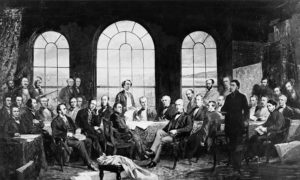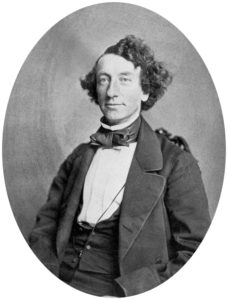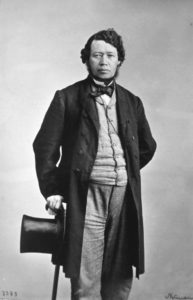Read the Following Selection
Read the following selection, or click on the play button below to listen aloud.
Fathers of Confederation
In 1867, Canada became a country. This confederation, or union, of a number of separate colonies, was due to the hard work of a group of men who became known as the Fathers of Confederation.

“Fathers of Confederation” by Robert Harris, 1884
Canada in Danger
By the 1860s, it was clear to the colonies in what is now Canada that it was time to make a change. The United States was a large and prosperous country and was threatening to take over the group of colonies. In the past, Great Britain had defended its Canadian colonies, but Britain no longer wanted to pay for this defence.
There were more difficulties within the colonies. The colonies were not growing quickly because the lack of transportation between colonies made it difficult for them to sell goods to one another.
On July 1, 1867, New Brunswick, Nova Scotia, Ontario (formerly Upper Canada), and Québec (formerly Lower Canada) joined together to become stronger and more successful. The Fathers of Confederation dreamed of a powerful new nation stretching from the Atlantic Ocean to the Pacific Ocean.
The Most Famous Fathers of Confederation

John A. Macdonald, 1858
There were 36 Fathers of Confederation. Probably the best known was John A. Macdonald. “Whatever you do, adhere to the Union,” said Macdonald. “We are a great country, and shall become one of the greatest in the universe if we preserve it …” Macdonald worked so hard to make confederation happen that he was elected as the first prime minister of Canada.

Charles Tupper, 1896
Another Father of Confederation, Charles Tupper, also became one of Canada’s prime ministers. But he was in office for only 69 days, in 1896, making him the shortest-serving prime minister ever. Thomas D’Arcy McGee was another Father of Confederation. He was known as the best public speaker of his time.
The Country Grows

Thomas D’Arcy McGee, 1863
Thanks to the Fathers of Confederation and their work, the country continued to grow. The rest of the provinces and territories joined Confederation in the following years:
1870: Manitoba, Northwest Territories
1871: British Columbia
1873: Prince Edward Island
1898: Yukon
1905: Alberta, Saskatchewan
1949: Newfoundland and Labrador
1999: Nunavut
Now, show what you know!
Complete some questions about the reading selection by clicking “Begin Questions” below.









